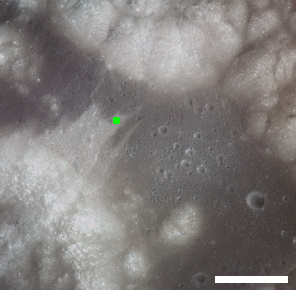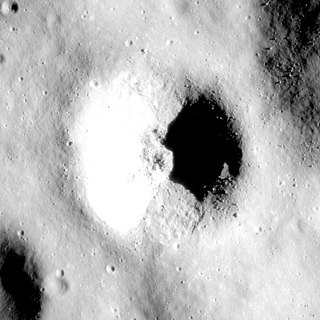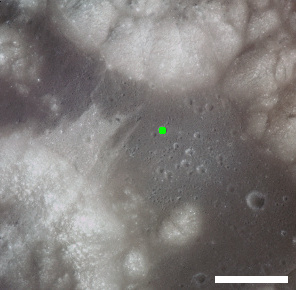
Mare Cognitum is a lunar mare located in a basin or large crater which sits in the second ring of Oceanus Procellarum. To the northwest of the mare is the Montes Riphaeus mountain range, part of the rim of the buried crater or basin containing the mare. Previously unnamed, the mare received its name in 1964 in reference to its selection as the target for the successful impact probe Ranger 7, the first American spacecraft to return closeup images of the Moon's surface.

Aldrin is a small impact crater located on the southern part of the Mare Tranquillitatis, to the east of Sabine. It is located about 50 kilometers to the northwest of the Apollo 11 landing site, Tranquility Base. Named after Buzz Aldrin, the crater is the westernmost of a row of three craters named in honor of the Apollo 11 crew members. About 30 kilometers to the east is the landing site of the Surveyor 5 lunar probe.

Armstrong is a small lunar impact crater located in the southern part of the Mare Tranquillitatis. It lies about 50 kilometers to the northeast of the Apollo 11 landing site, Tranquility Base. Named after American astronaut Neil Armstrong, the crater is the easternmost of the row of three craters named in honor of the Apollo 11 crew members. To the north is the Ranger 8 impact site.

Collins is a tiny lunar impact crater located on the southern part of the Mare Tranquillitatis. It is located about 25 kilometers to the north of the Apollo 11 landing site, Tranquility Base. Named after American astronaut Michael Collins, the crater is the central member of the row of three craters named in honor of the Apollo 11 crew members. About 15 kilometers to the west-northwest is the landing site of the Surveyor 5 lunar probe.

Moltke is a lunar impact crater near the southern edge of the Mare Tranquillitatis. It is a small, bowl-shaped crater surrounded by a bright halo of higher-albedo material. Just to the south lies the rille system named Rimae Hypatia. These follow a course running roughly east-southeast to west-northwest, and have a length of approximately 180 kilometers.

Proclus is a young lunar impact crater located to the west of the Mare Crisium, on the east shore of the Palus Somni. Its diameter is 27 km. It was named after 5th century Greek mathematician, astronomer and philosopher Proclus.

Sabine is a lunar impact crater that forms a nearly matching pair with Ritter to the northwest. The two rims are separated by a distance of only a couple of kilometers. To the west is the bowl-shaped crater Schmidt, and farther to the north are Manners and Arago. Its diameter is 30 km. It was named after Irish physicist and astronomer Edward Sabine.

Apollo, also called the Apollo basin, is an enormous impact crater located in the southern hemisphere on the far side of the Moon. This formation dwarfs the large crater Oppenheimer that is located next to the western rim. The crater Barringer lies across the northern wall. To the southeast is the crater Anders, and Kleymenov is just to the east of the rim.

Dollond is a small lunar impact crater that is located in the central region of the Moon, to the north of the crater Abulfeda. It was named after British optician John Dollond. Due west of Dollond is Anděl. Dollond is circular and cone shaped, with a tiny floor at the midpoint of the sloping interior walls.

Tranquility Base is the site on the Moon where, in July 1969, humans landed and walked on a celestial body other than Earth for the first time. On July 20, 1969, Apollo 11 crewmembers Neil Armstrong and Buzz Aldrin landed their Apollo Lunar Module Eagle at approximately 20:17:40 UTC. Armstrong exited the spacecraft six hours and 39 minutes after touchdown, followed 19 minutes later by Aldrin. The astronauts spent two hours and 31 minutes examining and photographing the lunar surface, setting up several scientific experiment packages, and collecting 47.5 pounds (21.5 kg) of dirt and rock samples for return to Earth. They lifted off the surface on July 21 at 17:54 UTC.

Mons Hadley is a massif in the northern portion of the Montes Apenninus, a range in the northern hemisphere of the Moon. It has a height of 4.5 km (2.8 mi) 14,764 ft (4,500 m) above the adjacent plain and a maximum diameter of 25 km at the base.

Shorty is a feature on Earth's Moon, an impact crater in the Taurus–Littrow valley. Astronauts Eugene Cernan and Harrison Schmitt visited it in 1972, on the Apollo 17 mission. It is the location of the famous "orange soil", which geologists believe to be small bits of rapidly-cooled molten rock ejected in a fire fountain. It is about 110 meters in diameter and up to 14 m (15 yd) deep.
Shorty Crater is about 14 m deep. Based on our investigations at the site and later examination of photographs, the impact that formed it penetrated, in order, regolith on the avalanche deposit, the avalanche deposit, regolith on a basalt flow, a basalt flow overlying and protecting the orange and black glass layers, the orange and black glass layers, regolith on a second basalt flow, and, finally, the upper portion of that second flow. Orange and black glass clods and basalt boulders are spread throughout the ejecta blanket surrounding Shorty.

North Ray crater is a small crater in the Descartes Highlands of the Moon visited by the astronauts of Apollo 16. The name of the crater was formally adopted by the IAU in 1973. It is the largest crater sampled by astronauts during the Apollo program.

South Ray crater is a small crater in the Descartes Highlands of the Moon photographed from the lunar surface by the astronauts of Apollo 16. The name of the crater was formally adopted by the IAU in 1973.

Camelot is a feature on Earth's Moon, a crater in Taurus-Littrow valley. Astronauts Eugene Cernan and Harrison Schmitt visited it in 1972, on the Apollo 17 mission, during EVA 2. Geology Station 5 was along the south rim of Camelot.

Victory is a feature on Earth's Moon, a crater in Taurus–Littrow valley. Astronauts Eugene Cernan and Harrison Schmitt visited it in 1972, on the Apollo 17 mission, during EVA 2. The astronauts stopped at the south rim of Victory on their way back to the Lunar Module from Shorty crater.

West crater is a small crater in Mare Tranquillitatis on the Moon, east of the Apollo 11 landing site, which is known as Tranquility Base. The name of the crater was formally adopted by the IAU in 1973.

Little West is a small crater in Mare Tranquillitatis on the Moon, east of the Apollo 11 landing site known as Tranquility Base.

Spook crater is a small crater in the Descartes Highlands of the Moon visited by the astronauts of Apollo 16. The name of the crater was formally adopted by the IAU in 1973. Geology Station 2 is adjacent to Spook, between it and the smaller, younger crater called Buster to the north of it.

Surveyor crater is a small crater in Mare Cognitum on the Moon. The name of the crater was formally adopted by the IAU in 1973.




















